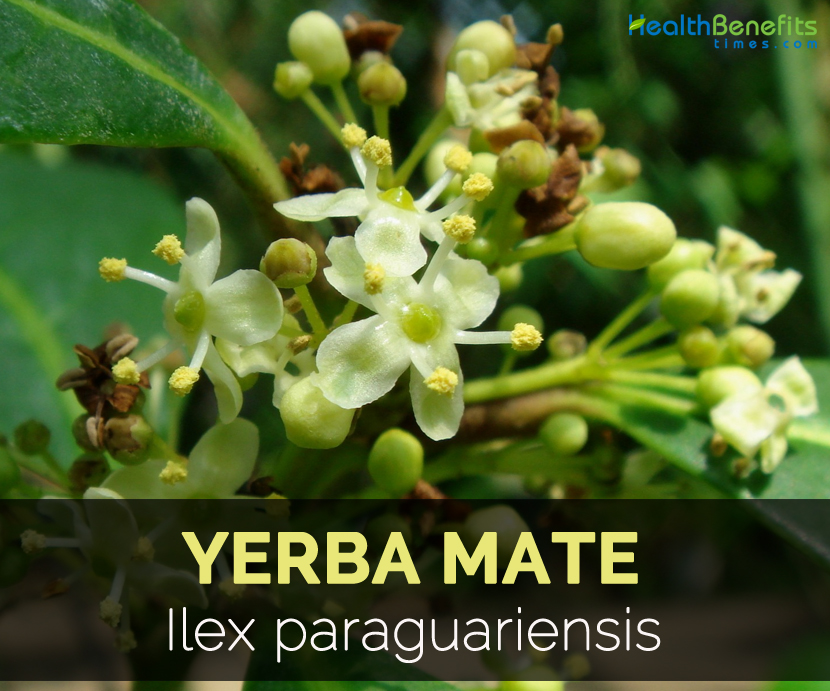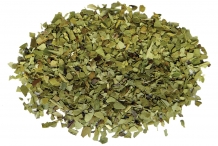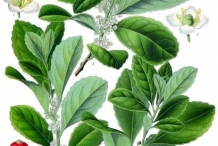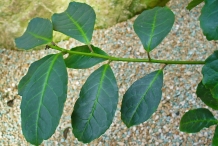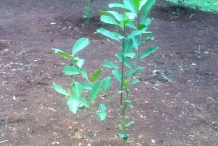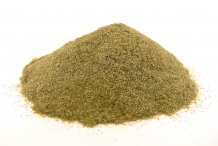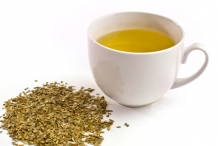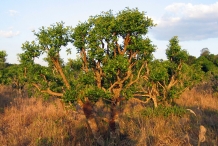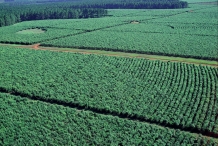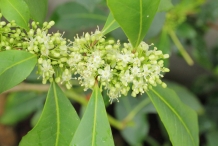Yerba Mate is an evergreen tree measuring about 15 meters tall with evergreen leaves of 7-11 cm long and 3-5.5 cm wide. The small flowers are greenish to white with four petals. The showy fruit is a dark red or purple drupe about 4-6 mm in diameter that ripens in autumn. Pollination is entomophilous. The pollens are carried by insects such as flies and bees. The plant flowers in spring. It is popular for its ability to burn fat and suppresses appetite. It is helpful for cardiovascular system and heart health. Yerba mate occurs in the banks of streams and rivers. It prefers clay or sand soils which are high in potassium and phosphoric acid along with acidic pH. It grows in subtropical and temperate regions with the requirement of high humidity levels but can tolerate very low temperatures.
It is a great source of caffeine and also possesses bioactive compounds such as ursolic acid and quercetin. It contains flavonoids, xanthines, cinnamic acid compounds and saponins. Yerba mate possesses three xanthines such as theophylline, theobromine and caffeine. The caffeine content alters from 0.7% to 1.7%, theophylline is available in small amounts or absent and the theobromine content alters from 0.3% to 0.9%. Elements such as magnesium, potassium and manganese are also present in Yerba Mate.
History
Well known as a beverage source called mate, it is consumed in Southern and Center-Western Brazil, Argentina, Bolivia, Paraguay, Uruguay and Southern Chile. It is imported from Argentina and was well-known in Syria. Firstly it was cultivated and used by Guarani people and Tupi communities of Southern Brazil and Paragyay and was widely spread with European colonization. In late 16th century, both indigenous Guaranis and Spanish settlers consume it. In 17th century, the consumption of Yerba Mate spread to River Plate, Chile, Argentina, Peru and Bolivia.
Jesuits domesticated the plant in the mid-17th century and started plantations in Argentina and Misiones. In 1770s, after their exclusion, the plantations chop down to decay and their domestication. After independence, the industry was vital important for Paraguayan economy but development of Paraguayan state was interrupted after the War of the Triple Alliance from 1864 to 1870 which wrecked the country both demographically and economically.
In the late 19th and early 20th centuries, the plant was domesticated in Argentine and Brazilian projects which opened the way for plantation. Today Brazil is the highest producer by 53% which is followed by Argentina (37%) and Paraguay (10%).
Plant
Yerba Mate is an evergreen shrub or tree with oblong to oval crown and pale bark and grows upto the height of 20 m tall.
Flower & Fruit
Flowers are in white color, are axillary and grow in the clusters of 40 to 50. They have 4-5 petalled corolla, 4-5 sepaled calyx, dioecious and are unisexual by abortion so it is functionally dioecious. Both female and male flowers form small clusters in the axils of leaves. Each sepals measures 1 mm by 1 mm and each petals are about 3 mm by 2 mm. Corolla lobes are about 1.5 to 2 mm long with a four celled ovary.
Fruit
The flowers then turn into globose shaped, dark red or purple drupes containing which contains 5 to 8 seeds. Drupes are about 4 to 6 mm in diameter and its size resembles small peas.
Leaves
The plant bears alternate leaves, oblong to oval in shape and is acuminate with serrate or crenate margins. Leaves are leathery, glossy and pale green on lower surface & dark green on above surface. It has dark red petioles which is 1.27 cm long. The leaves are tough, coriaceous and measures about 7 to 11 cm long and 3 to 5.5 cm wide.
Health Benefits of Yerba Mate
Yerba Mate acts as a diuretic, tonic and stimulant that helps to lower fatigue, aids gastric function and also suppress appetite. It is used as a depurative that promotes elimination of waste. The bitter qualities found in Yerba Mate supports digestion. It is useful for nervous depression, weight loss, psychogenic, physical and mental fatigue, headaches and rheumatic pains. Yerba Mate is a well-known for losing weight in Germany. It possesses xanthine which is a chemical that enhance metabolism and is also rich in pantothenic acid that prevents overstimulation of nervous system. The antioxidant properties enhance immunity which is helpful for preventing flu and colds.
- Lose weight
Polyphenols such as phenolic acids and flavonoids found in Yerba Mate inhibits enzymes such as lipoprotein lipase and pancreatic lipase which plays vital role in metabolism of fats. Polyphenols lowers triglycerides, serum levels of glucose and LDL. It slows gastric emptying that helps to increase satiety. It lowers the absorption of dietary fats and also alters the metabolism of cholesterol. In addition, it is not recommended over physical exercise and diet. It slows down digestion process so the stomach becomes full for long time period. Add Yerba Mate along with regular exercise and healthy diet that promotes metabolism that burns more calories and helps to eat less.
- Prevent colon cancer
The caffeine derivatives found in Yerba Mate tea leads to death in colon cancer cells along with lowering markers of inflammation which promotes the progression of cancer. As its DNA is damaged, the cancer cell destructs itself. It is able to induce cell death or apoptosis in all cancer types. The mechanism has been identified which leads to death of cells. The result derived from the conducted study shows that the caffeine derivatives found in Yerba Mate tea possess anti-cancer properties and also helpful for diseases related with inflammation. (1)
- Treat inflammation
Yerba Mate is attributed for phenolic compounds. The study results antimicrobial activity of ethanolic and methanolic extracts of Yerba Mate against Staphylococcus aureus, Salmonella Enteritidis, Listeria monocytogenes and Escherichia coli which are food pathogens. The research shows that Yerba Mate has antimicrobial properties that prevent the health conditions caused by bacteria named E. coli. It has flavonoids which is effective to lower inflammation. The anti-inflammatory properties found in Yerba Mate helps to lower the chances of chronic diseases and also promote overall health. (2)
- Strengthen immunity
Yerba Mate contains saponins and polyphenols. Saponins are phytochemicals which are found in abundant amount naturally. It is beneficial for cancer, blood cholesterol levels and bone health. It promotes immunity and prevents body against diseases. It has anti-inflammatory activity. The intake of Yerba Mate increases phytochemicals intake that helps to strengthen body’s immunity naturally. The plant based compounds harmonize overactive immune response that leads to inflammatory bowel disease, seasonal allergies, rheumatoid arthritis, multiple sclerosis and diabetes.
- Nutrient intake
Yerba Mate has Vitamin C, A, B1, E, B2, B complex, B5 and Niacin. Besides vitamins, it also contains minerals such as manganese, calcium, selenium, iron, magnesium, potassium, zinc and phosphorus. Additionally, it possess health promoting compounds such as fatty acids, carotene, flavonols, chlorophyll, fatty acids, trace minerals, inositol, polyphenols, tannins, fatty acids, antioxidants and 15 amino acids. One cup of Yerba Mate provides all these nutrients which promote overall health.
- Lowers cholesterol
The study shows that Yerba Mate tea promotes serum lipid level by lowering the level of cholesterol. The study shows that intake of Yerba Mate lowers bad cholesterol. The reduction of bad cholesterol lowers the chances of various cardiovascular ailments. Yerba Mate prevents the conditions such as irregular heartbeat, heart failure and low blood pressure. The antioxidant and anti-inflammatory properties protect cardiovascular health and heart health. Theobromine found in Yerba Mate relaxes blood vessels that allow better flow of blood. It prevents the chances of arteriosclerosis and blood clots that leads to stroke and heart attack. The research shows that Yerba Mate has good impact on lipid parameters and also lowers LDL cholesterol in hypercholesterolemic patients. Its intake protects myocardial tissue of heart and lowers oxidative stress caused due to reactive oxygen species.
- Bone health
An intake of Yerba Mate tea promotes the bone density even in those people who don’t exercise. The study shows that the post-menopausal women drank Yerba mate tea regularly which results in greater bone density in spines by 10% in comparison to those who did not consume. Yerba Mate contains various minerals which are needed for mineral density of bones in the body. Phosphorus, iron, calcium, zinc and potassium are the parts of process that prevents the chances of osteoporosis.
- Mental activity
Caffeine is found in moderate amounts in Yerba Mate which is used as a psychoactive drug. It helps to promote mood, memory and alertness. It stimulates production of neurotransmitter dopamine. Yerba mate also possesses compounds such as theophylline and theobromine along with caffeine. These alkaloids provide mild stimulant effects similar to green tea. Yerba Mate tea has vitamins, minerals, amino acids, antioxidants and polyphenols that provide balancing effect on caffeine. It increases mental focus, clarity and energy. The antioxidants found in Yerba Mate tea prevent deposition of plaque in brain that counteracts the effects of dementia and Alzheimer’s disease as well.
- Supports digestion
Yerba Mate tea has been used by South American people as an aid for digestive problems. It supports digestion by stimulating increased production of gastric acids and bile. It effectively cleans colon and eliminates waste and also lowers stomach bacteria that causes bad breathe. It increases the flow of bile and enhance intestinal tract. The plant of Mate has unique compounds such as xanthines that promote relaxation of muscles that is good for digestion and prevents bloating, constipation, cramping and other digestive problems.
- Antioxidant activity
The intake of Yerba Mate contains various phytochemicals such as chlorogenic acid, polyphenols and caffeoyl derivatives which acts as antioxidants. The research shows that the extracts of Yerba Mate lower oxidative stress which increases the chances of damage to heart and liver. It lowers nitrosative stress that damages DNA, lipid peroxidation and cell death. In comparison to the green tea, Yerba Mate effectively prevents cytotoxicity related with restriction of blood flower heart disorders like stroke. The antioxidant activities help in prevention of heart disease, blood flow problems, autoimmune disorders and prevents aging.
Traditional uses
- Yerba Mate is used as a treatment for fatigue, psychogenic headache, rheumatic pains, nervous depression and headache related with fatigue.
- Dried and roasted leaves are used for medicinal purposes.
- The herb is used for physical and mental fatigue.
- Yerba Mate is used internally in folk medicine for treating anemia, ulcers, rheumatism, depression, neurasthenia and as a prophylaxis against infections and fevers and as a diuretic for oliguria.
- Use it as a poultice externally for inflammation and ulcers.
- This herb is useful for treating poor digestion.
- An infusion could be prepared by pouring boiled water in 1 teaspoonful of drug and let it remain for 5-10 minutes and then strain it. This infused drink is less astringent, more stimulating and also tastes better.
- It is able to stimulate central nervous system.
- Yerba Mate is beneficial for cardiovascular health and assist in managing obesity.
- The polyphenols in Yerba Mate assist to enhance immunity, lower the chances of diabetes mellitus, hyperglycemia and also relieve allergies.
- Yerba Mate helps to suppress appetite, lose weight, also helps to burn more calories, increase focus, supply of oxygen and nutrient to heart, promote sleep and enhance mood.
- It is used to prevent cancer as it could stop the growth of cancer cells.
- The plant is useful to provide relief from mental and physical stress, urinary tract infections, joints, headaches, chronic fatigue syndrome.
- It is used for treating heart complaints such as irregular heartbeat, heart failure and low blood pressure.
- It is an aid for kidney stones and bladder problems.
- In Brazil, it is used for renal colic, digestive problems, obesity, nerve pain, fatigue and depression.
- Apply it topically for ulcers, burns and antibacterial patch.
Precautions
- Side effects include tremor, anxiety, sleeplessness, withdrawal headach and palpitations.
- Its excessive use increases the chances of oesophageal cancer in men and women.
- An individual having cardiac disorder and hypertension should not use Yerba Mate.
- Warnings related with caffeine are also applicable.
- Pregnant women and breastfeeding mothers should restrict the use of Yerba Mate.
- Its daily use is associated with increasing risk of lung, prostate, head, esophageal and neck cancers.
- Overdose of Mate tea increases the chances of several types of cancers.
- Yerba Mate should not be used with heart or blood pressure medications, chemotherapy drugs, stimulant drugs and drugs for depression.
- Should not be used by the patients of cardiac disorders, hypertension and anxiety.
- It is unsafe to use for children.
How to Eat
- Yerba Mate is consumed as a beverage in Bolivia, Argentina, Uruguay, Center-Western and Southern Brazil, Southern Chile and Paraguay.
- The dried and chopped leaves are ground into powdery mixture which is called yerba.
- In Paraguay, Yerba Mate tea is used as a refreshing and stimulating drink.
- It could be used as a part of tea and soft drinks.
References:
https://www.itis.gov/servlet/SingleRpt/SingleRpt?search_topic=TSN&search_value=506475#null
https://davesgarden.com/guides/pf/go/56956/
http://www.hear.org/pier/species/ilex_paraguariensis.htm
https://www.mskcc.org/cancer-care/integrative-medicine/herbs/mate
https://medlineplus.gov/druginfo/natural/828.html
http://www.herbwisdom.com/herb-yerba-mate.html
https://examine.com/supplements/yerba-mate/
https://bebrainfit.com/yerba-mate-benefits/
https://www.livestrong.com/article/258209-benefits-of-yerba-mate-tea/
https://www.organicfacts.net/yerba-mate.html
Comments
| Yerba Mate Quick Facts | |
|---|---|
| Name: | Yerba Mate |
| Scientific Name: | Ilex paraguariensis |
| Origin | Yerba Mate is native to subtropical South America. It is extensively used in Argentina, Paraguay, Brazil and Uruguay. |
| Colors | Reddish |
| Shapes | Drupe, globoid |
| Taste | Astringent, bitter |
| Health benefits | Cure constipation, Treat headaches and fatigue, Cure obesity, Tones nervous system, Enhance memory |
| Name | Yerba Mate |
|---|---|
| Scientific Name | Ilex paraguariensis |
| Native | Yerba Mate is native to subtropical South America. It is extensively used in Argentina, Paraguay, Brazil and Uruguay. |
| Common/English Name | Paraguay Tea, Jesuit’s Tea, Ilex Species, Paraguayan Tea, St. Bartholomew’s tea, Ilex, Jesuit’s tea, Guyaki Paraguay tea, Hervea, Cimmaron, Chimarrão, Green Mate, Jesuit’s Brazil Tea, Maté Folium, Maté, Thé de Saint Barthélémy, Thé du Brésil, Thé des Jésuites, Thé du Paraguay, Yerbamate |
| Name in Other Languages | English: Brazilian-tea, Paraguay tea, Paraguayan-tea, Mate; German: Mateteestrauch; Portuguese: Erva-mate; Swedish: Mate; Spanish: Mate, Yerba mate; French: Thé du Paraguay; Brazilian Portuguese: carvalho branco, caáguaçu, caúna, erva mate, Erva-mate, erveira, mate; Finnish: Matee; German: mate; Guarani: caá gua zú; Portuguese: congonha, herva-maté; Spanish: té de los jesuitas, Yerba Mate; |
| Plant Growth Habit | Evergreen shrub or small tree, perennial |
| Plant Size | 20 m tall |
| Bark | Pale, smooth, shiny, brownish to grayish or greenish |
| Leaf | Alternate, obolong, oval, 7-11 cm long, 3-5.5 cm wide |
| Flower | White, unisexual, dioecious, 1-2 cm long |
| Fruit shape & size | Drupe, globoid |
| Fruit color | Reddish |
| Odor | Characteristic, aromatic |
| Plant parts used | Leaf |
| Seed | Five to eight |


